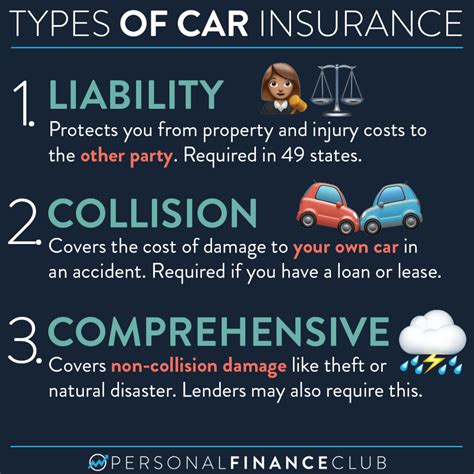Insurance Automobile

Automobile insurance, also known as car insurance or auto insurance, is a crucial aspect of vehicle ownership and an essential financial safeguard for drivers worldwide. This comprehensive guide aims to provide an in-depth analysis of the world of automobile insurance, exploring its importance, the various types of coverage, the claims process, and the key factors influencing insurance rates. With the ever-evolving landscape of the automotive industry and the increasing complexity of modern vehicles, understanding automobile insurance has become more critical than ever.
Understanding the Importance of Automobile Insurance

Automobile insurance serves as a vital protection measure for vehicle owners, offering financial security in the event of accidents, theft, or other unforeseen circumstances. The primary objective of this insurance is to mitigate the potentially devastating financial consequences that can arise from vehicular incidents. By providing coverage for repairs, medical expenses, and legal liabilities, automobile insurance ensures that policyholders are not left financially burdened by unexpected events.
Furthermore, automobile insurance plays a significant role in promoting road safety. Insurance providers often incentivize safe driving practices by offering discounts to policyholders with clean driving records. This not only reduces the likelihood of accidents but also encourages a culture of responsible driving, contributing to overall road safety for all motorists.
Types of Automobile Insurance Coverage

Automobile insurance policies can be tailored to meet the specific needs and circumstances of individual policyholders. Here’s a breakdown of the primary types of coverage available:
Liability Coverage
Liability insurance is a fundamental component of automobile insurance policies. It covers the policyholder’s legal responsibility for bodily injury or property damage caused to others in an accident for which they are at fault. This coverage is mandatory in most countries and is designed to protect the policyholder from potentially devastating financial consequences resulting from a lawsuit or settlement.
Collision Coverage
Collision coverage is an optional addition to automobile insurance policies. It provides protection for the policyholder’s vehicle in the event of a collision with another vehicle or object, regardless of fault. This coverage is particularly beneficial for individuals with newer or more expensive vehicles, as it ensures that repair or replacement costs are covered, even if the policyholder is at fault.
Comprehensive Coverage
Comprehensive coverage is another optional component of automobile insurance policies. It offers protection against damage or loss caused by events other than collisions, such as theft, vandalism, natural disasters, or collisions with animals. Comprehensive coverage provides a more comprehensive level of protection, ensuring that policyholders are not left to bear the financial burden of unexpected events.
Personal Injury Protection (PIP)
Personal Injury Protection, commonly known as PIP, is a crucial component of automobile insurance policies, particularly in no-fault states. PIP coverage provides compensation for medical expenses, lost wages, and other related costs incurred by the policyholder and their passengers in an accident, regardless of fault. This coverage ensures that policyholders receive the necessary medical treatment and financial support following an accident, regardless of the outcome of any legal proceedings.
Uninsured/Underinsured Motorist Coverage
Uninsured/Underinsured Motorist coverage is designed to protect policyholders in the event of an accident with a driver who either has no insurance or has insufficient insurance coverage. This coverage provides compensation for bodily injury, property damage, or both, ensuring that policyholders are not left to bear the financial burden of an accident caused by an uninsured or underinsured driver.
The Automobile Insurance Claims Process
Understanding the claims process is essential for policyholders to ensure a smooth and efficient resolution of their insurance claims. Here’s an overview of the typical steps involved in the automobile insurance claims process:
Reporting the Claim
The first step in the claims process is to promptly report the incident to the insurance provider. Policyholders should provide accurate and detailed information about the accident, including the date, time, location, and circumstances of the event. It’s crucial to document any relevant evidence, such as photographs of the damage, witness statements, and police reports, as these can be invaluable in supporting the claim.
Assessment and Investigation
Once the claim has been reported, the insurance provider will assess the extent of the damage and investigate the circumstances of the accident. This process may involve a physical inspection of the vehicle, review of police reports, and interviews with witnesses or other involved parties. The insurance provider will then determine the coverage applicable to the claim and assess the value of the damages.
Claims Settlement
Upon completion of the assessment and investigation, the insurance provider will settle the claim. This typically involves the insurance company issuing a payment to cover the cost of repairs, medical expenses, or other applicable expenses. In some cases, the insurance provider may also provide a rental car or other temporary transportation while the policyholder’s vehicle is being repaired.
Factors Influencing Automobile Insurance Rates
Automobile insurance rates can vary significantly based on a multitude of factors. Understanding these factors can help policyholders make informed decisions about their insurance coverage and potentially identify opportunities to reduce their premiums.
Vehicle Type and Usage
The type of vehicle and its intended usage are significant factors in determining insurance rates. Generally, newer and more expensive vehicles, as well as those with high-performance engines or luxury features, tend to have higher insurance premiums. Additionally, vehicles that are primarily used for business purposes or are driven frequently may also attract higher insurance rates.
Driver Profile
The driver’s profile, including their age, gender, driving record, and years of driving experience, plays a crucial role in determining insurance rates. Younger drivers, particularly those under the age of 25, are often considered higher risk and may face higher insurance premiums. Similarly, drivers with a history of accidents, traffic violations, or claims may also be subject to higher rates.
Location and Mileage
The policyholder’s location and annual mileage are also considered in determining insurance rates. Areas with higher rates of accidents, thefts, or vandalism may result in increased insurance premiums. Additionally, policyholders who drive frequently or travel long distances may also face higher rates, as the increased exposure to potential risks is taken into account.
Coverage and Deductibles
The level of coverage and deductibles chosen by the policyholder can significantly impact insurance rates. Opting for higher levels of coverage or lower deductibles generally results in higher premiums. Policyholders should carefully consider their coverage needs and financial situation to strike the right balance between protection and affordability.
Future Trends and Innovations in Automobile Insurance

The world of automobile insurance is continually evolving, driven by advancements in technology and changes in the automotive industry. Here’s a glimpse into some of the future trends and innovations that are likely to shape the landscape of automobile insurance:
Telematics and Usage-Based Insurance
Telematics technology, which involves the use of devices to track driving behavior and vehicle performance, is gaining traction in the insurance industry. Usage-based insurance, also known as pay-as-you-drive or pay-how-you-drive insurance, utilizes telematics data to offer personalized insurance rates based on an individual’s actual driving behavior. This innovative approach to insurance pricing is expected to become increasingly prevalent, providing policyholders with more accurate and fair premiums based on their individual driving habits.
Autonomous Vehicle Insurance
The emergence of autonomous vehicles is poised to revolutionize the automotive industry and present new challenges for insurance providers. As self-driving cars become more prevalent, the liability for accidents will shift from individual drivers to the vehicle’s manufacturer or technology provider. Insurance providers will need to adapt their policies and coverage to address the unique risks and responsibilities associated with autonomous vehicles, ensuring that policyholders are adequately protected in this evolving landscape.
Data-Driven Risk Assessment
Advancements in data analytics and machine learning are enabling insurance providers to make more accurate risk assessments. By analyzing vast amounts of data, including driving behavior, vehicle performance, and environmental factors, insurance companies can identify patterns and trends that influence the likelihood of accidents. This data-driven approach to risk assessment is expected to enhance the accuracy and fairness of insurance premiums, benefiting both policyholders and insurance providers.
Conclusion
Automobile insurance is a critical component of responsible vehicle ownership, offering financial protection and peace of mind to policyholders. By understanding the various types of coverage, the claims process, and the factors influencing insurance rates, individuals can make informed decisions about their insurance needs. As the automotive industry continues to evolve, with advancements in technology and the emergence of autonomous vehicles, the world of automobile insurance is set to undergo significant transformations, ensuring that policyholders receive the protection and support they need in an ever-changing landscape.
What is the average cost of automobile insurance?
+The average cost of automobile insurance varies significantly based on numerous factors, including the policyholder’s location, vehicle type, driving record, and coverage choices. According to industry data, the average annual premium for automobile insurance in the United States is approximately $1,674, although this figure can range widely depending on individual circumstances.
How can I reduce my automobile insurance premiums?
+There are several strategies to potentially reduce automobile insurance premiums. These include maintaining a clean driving record, increasing your deductible, bundling policies with the same insurer, and taking advantage of discounts for safe driving practices or vehicle safety features. Additionally, shopping around and comparing quotes from multiple insurers can help identify the most competitive rates.
What should I do if I’m involved in an accident?
+If you’re involved in an accident, the first step is to ensure your safety and the safety of others involved. Call emergency services if needed. Then, promptly report the accident to your insurance provider, providing detailed information about the incident. Document the scene with photographs and collect any relevant evidence, such as witness statements or police reports. Cooperate with your insurance provider’s investigation and follow their guidance throughout the claims process.
Can I switch automobile insurance providers?
+Yes, you have the right to switch automobile insurance providers at any time. Shopping around for the best rates and coverage options is a wise practice, as insurance premiums can vary significantly between providers. When switching, ensure that your new policy provides adequate coverage and has no gaps in protection. Some insurers may offer incentives, such as discounts or promotional rates, to attract new policyholders, so it’s worth exploring these options.



